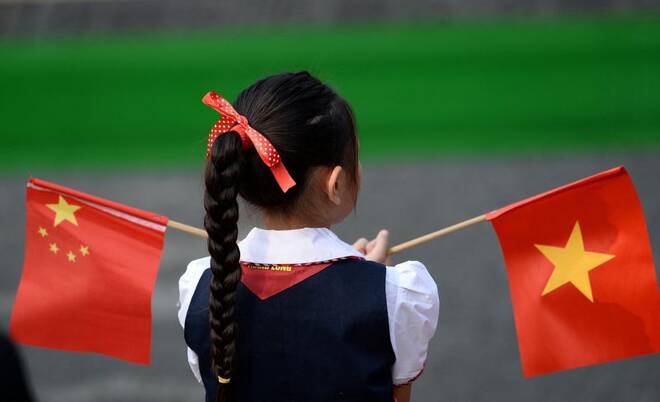Advertisement
Advertisement
Analysis-Chinese suppliers race to Vietnam as COVID let-up opens escape route from Sino-U.S. trade war
By:
By Francesco Guarascio HANOI (Reuters) - Vietnam has enjoyed a wave of investment from China since its neighbour abruptly canned its strict virus-containment strategy and unleashed pent-up interest from companies - and their suppliers - fleeing the impact of Sino-U.S. trade friction.
By Francesco Guarascio
HANOI (Reuters) – Vietnam has enjoyed a wave of investment from China since its neighbour abruptly canned its strict virus-containment strategy and unleashed pent-up interest from companies – and their suppliers – fleeing the impact of Sino-U.S. trade friction.
After China ended its zero-COVID-19 policy in December, Chinese firms spent the first 50 days of 2023 investing in 45 new projects in Vietnam, the most from a single country, Vietnamese government data showed.
With big-name players already in the Southeast Asian nation, attracted by its free-trade agreements and proximity to China, the companies making up the current wave of investors are mostly smaller suppliers to those larger firms, industry experts said.
Adding impetus to the move is the increasing cost of labour in China, expanding U.S. restrictions on high-tech-related trade with China, and tit-for-tat tariffs from a Sino-U.S. trade war that triggered a past wave of Chinese investment in Vietnam.
“Enquiries from Chinese firms about manufacturing investment in Vietnam grew exponentially in the last quarter of last year,” said Michael Chan, senior director of leasing at industrial real estate specialist BW Industrial Development.
“Chinese investment has also increased remarkably,” he said.
Border crossing
The earlier influx of major foreign corporations such as Samsung Electronics Co Ltd, Canon Inc and Apple Inc device assemblers Hon Hai Precision Industry Co Ltd (Foxconn) and Luxshare Precision Industry Co Ltd contributed to rapid expansion of industrial clusters in sectors as varied as smartphones and printers.
But supplies for many still largely came from China. That country accounted for more than 20% of imported input for Vietnamese exports in 2021, nearly twice as much as in 2017, showed calculations from trade expert David Dollar of U.S. think tank Brookings Institution based on Asian Development Bank data.
Those smaller firms offering supplies and services to larger corporations with facilities already in Vietnam now make up the bulk of Chinese companies investing in Vietnam, particularly in the north just across the border, industry executives said.
The size of these suppliers is reflected in the average Chinese spend on new Vietnamese projects this year of roughly $5.6 million, compared with a long-term average of $6.5 million.
For instance, in Vietnam’s solar panel industry, which is dominated by Chinese firms, there has been an inflow of providers of support services such as plastic moulding, die casting and energy storage, industry sources said.
Last year, Chinese panel maker suppliers, including power storage firm Growatt, were behind two of the main investments in Vietnam in ready-made factories, showed data from U.S real estate consultancy CBRE Group. Such factories are often favoured by smaller firms when entering new countries.
Growatt did not respond to a Reuters request for comment.
Chinese electronics, robotics and home appliance firms were also among top spenders on industrial leases last year, the data showed. Others included flooring firms, glass makers and suppliers of cartons and components for Apple gadgets assembled by the likes of Foxconn and Luxshare, said Do Hong Quan, head of Vietnam Investment Consulting, whose focus is Chinese investors.
In total, while economies worldwide struggle to normalise following the pandemic, and with a consequent fall of foreign investment in Vietnam, Chinese firms have tripled spending on new building sites in Vietnam so far this year to $250 million versus the same period a year earlier, official data showed. That is second only to investment from Singapore, and more than traditionally bigger investors such as South Korea and Japan.
Koen Soenens, sales director at DEEP C industrial zone in northern Vietnam, told Reuters the number of contracts his firm signed with Chinese companies in 2022 rose steeply toward year-end and in the last quarter was significantly higher than the number of contracts signed with firms from any other country.
“We expect this trend to continue this year based on enquiries we are receiving from China,” Soenens said.
Among new partners, he cited automotive supplier Xiamen Sunrise Group Co Ltd, solar panel component maker Hanghzou First Applied Material Co Ltd and electric vehicle charging equipment maker Starchange. None of the companies responded to Reuters’ requests for comment.
Bloody history
Making the move is not without risk. With thousands of years of bloody history between the neighbours, competing claims in the South China Sea unleashed entrenched anti-Chinese sentiment in 2014 with Vietnamese rioters targeting Chinese factories.
Investment applications from Chinese firms tend to be vetted with extra care, resulting in delays or rejections which encourage investment through shell companies domiciled in Hong Kong or Singapore instead, industry experts and diplomats said.
Chinese firms also experience longer times to obtain staff visas and work permits, said Filippo Bortoletti, who heads the Vietnamese unit of investment consultancy Dezan Shira.
Neither the Ministry of Foreign Affairs nor the Ministry of Planning and Investment responded to requests for comment.
However, such risks are not enough to deter small firms.
“Chinese companies move here mostly to serve their clients who moved earlier,” said BW Industrial Development’s Chan.
(Reporting by Francesco Guarascio; Additional reporting by Phuong Nguyen and Khanh Vu in Hanoi and Brenda Goh in Shanghai; Editing by Christopher Cushing)
About the Author
Reuterscontributor
Reuters, the news and media division of Thomson Reuters, is the world’s largest international multimedia news provider reaching more than one billion people every day. Reuters provides trusted business, financial, national, and international news to professionals via Thomson Reuters desktops, the world's media organizations, and directly to consumers at Reuters.com and via Reuters TV. Learn more about Thomson Reuters products:
Latest news and analysis
Advertisement
